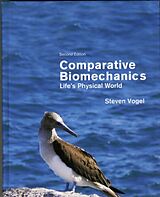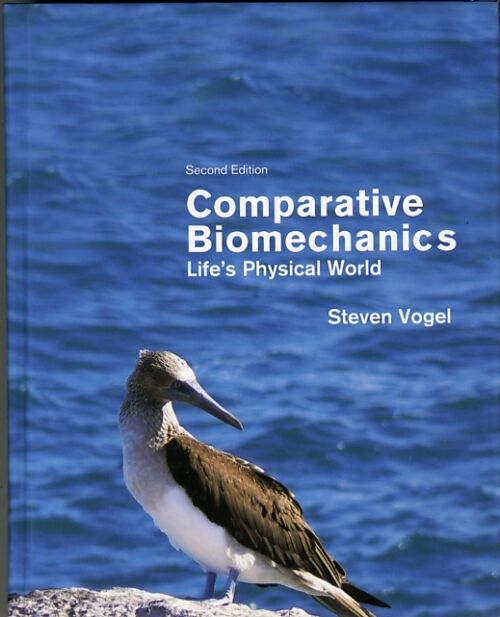Comparative Biomechanics
Einband:
Fester Einband
EAN:
9780691155661
Untertitel:
Life's Physical World - Second Edition
Genre:
Biologie
Autor:
Steven Vogel
Herausgeber:
Princeton University Press
Auflage:
2 Auflage Second Edition
Anzahl Seiten:
640
Erscheinungsdatum:
17.06.2013
ISBN:
978-0-691-15566-1
"[T]his is a fantastic book! . . . [T]here can be no doubt, this is a science book of the highest and finest quality. Students in biology and physics, including (mechanical) engineers, will find in this book a sound guideline for an alternative view of their respective disciplines. It is a source of inspiration, also for the interested layman, for further reflection on the realm of physics in the biological world."---Harold Heatwole, Integrative and Comparative Biology
Autorentext
Steven Vogel (1940–2015) was the James B. Duke Professor Emeritus of Biology at Duke University. His many books include Life's Devices (Princeton) and Cats' Paws and Catapults.
Klappentext
Comparative Biomechanics is the first and only textbook that takes a comprehensive look at the mechanical aspects of life--covering animals and plants, structure and movement, and solids and fluids. An ideal entry point into the ways living creatures interact with their immediate physical world, this revised and updated edition examines how the forms and activities of animals and plants reflect the materials available to nature, considers rules for fluid flow and structural design, and explores how organisms contend with environmental forces. Drawing on physics and mechanical engineering, Steven Vogel looks at how animals swim and fly, modes of terrestrial locomotion, organism responses to winds and water currents, circulatory and suspension-feeding systems, and the relationship between size and mechanical design. He also investigates links between the properties of biological materials--such as spider silk, jellyfish jelly, and muscle--and their structural and functional roles. Early chapters and appendices introduce relevant physical variables for quantification, and problem sets are provided at the end of each chapter.
Zusammenfassung
The classic textbook on comparative biomechanics—revised and expanded
Why do you switch from walking to running at a specific speed? Why do tall trees rarely blow over in high winds? And why does a spore ejected into air at seventy miles per hour travel only a fraction of an inch? Comparative Biomechanics is the first and only textbook that takes a comprehensive look at the mechanical aspects of life—covering animals and plants, structure and movement, and solids and fluids. An ideal entry point into the ways living creatures interact with their immediate physical world, this revised and updated edition examines how the forms and activities of animals and plants reflect the materials available to nature, considers rules for fluid flow and structural design, and explores how organisms contend with environmental forces.
Drawing on physics and mechanical engineering, Steven Vogel looks at how animals swim and fly, modes of terrestrial locomotion, organism responses to winds and water currents, circulatory and suspension-feeding systems, and the relationship between size and mechanical design. He also investigates links between the properties of biological materials—such as spider silk, jellyfish jelly, and muscle—and their structural and functional roles. Early chapters and appendices introduce relevant physical variables for quantification, and problem sets are provided at the end of each chapter. Comparative Biomechanics is useful for physical scientists and engineers seeking a guide to state-of-the-art biomechanics. For a wider audience, the textbook establishes the basic biological context for applied areas—including ergonomics, orthopedics, mechanical prosthetics, kinesiology, sports medicine, and biomimetics—and provides materials for exhibit designers at science museums.
Problem sets at the ends of chaptersAppendices cover basic background informationUpdated and expanded documentation and materialsRevised figures and textIncreased coverage of friction, viscoelastic materials, surface tension, diverse modes of locomotion, and biomimetics
Inhalt
Preface vii PART ONE Life's Physical Context 1 1 Preambulations 3 2 Setting the Stage 11 3 More Tools 29 PART TWO Fluids 51 4 Gases and Liquids: Fluids at Rest 53 5 Gases Meet Liquids: The Interface 71 6 Viscosity and the Patterns of Flow 87 7 The Forces of Flow 111 8 Fluid Events Near Surfaces 141 9 Where Flows Are Inside 163 10 More about Circulatory Systems 183 11 Flows in Small Worlds 207 12 About Lift 225 13 Thrust for Flying and Swimming 251 14 Motion at the Air-Water Interface 271 PART THREE Solids and Structures 285 15 A Matter of Materials 287 16 Biological Materials: Tuning Properties Properly 313 17 Biological Materials: Cracks and Composites 329 18 More about Complex Materials: Viscoelasticity 347 19 Simple Structures: Beams, Columns, Shells 363 20 Less Simple Structural Matters 389 21 Hydrostatic Structures, Hydraulic Devices 407 22 Structural Systems 425 23 Motility and Mobility 449 24 Using Muscle: Tuning and Transmissions 473 25 Getting Around on Land 491 PART FOUR The Contexts of Biomechanics 513 26 Loose Ends and Perspectives 515 APPENDICES 1 Quantification: Rules of the Road 537 2 Motion and Direction 547 3 Size and Scaling 553 List of Symbols 565 References and Index of Citations 567 Subject Index 601

Leider konnten wir für diesen Artikel keine Preise ermitteln ...
billigbuch.ch sucht jetzt für Sie die besten Angebote ...
Die aktuellen Verkaufspreise von 5 Onlineshops werden in Realtime abgefragt.
Sie können das gewünschte Produkt anschliessend direkt beim Anbieter Ihrer Wahl bestellen.
Loading...
Die aktuellen Verkaufspreise von 5 Onlineshops werden in Realtime abgefragt.
Sie können das gewünschte Produkt anschliessend direkt beim Anbieter Ihrer Wahl bestellen.
| # | Onlineshop | Preis CHF | Versand CHF | Total CHF | ||
|---|---|---|---|---|---|---|
| 1 | Seller | 0.00 | 0.00 | 0.00 |
